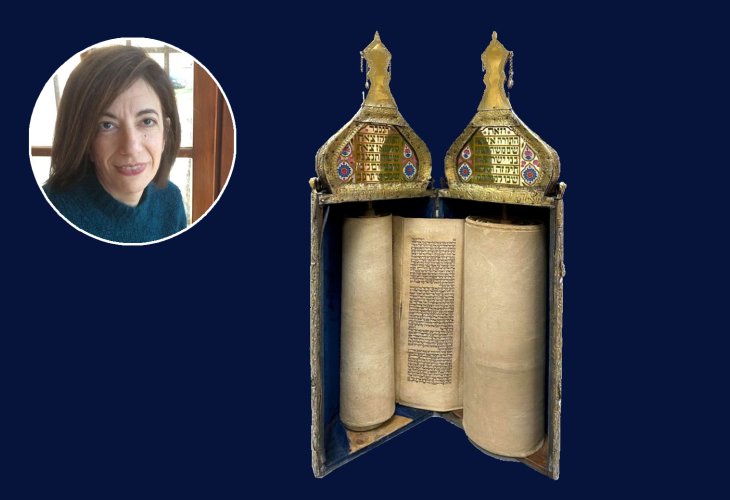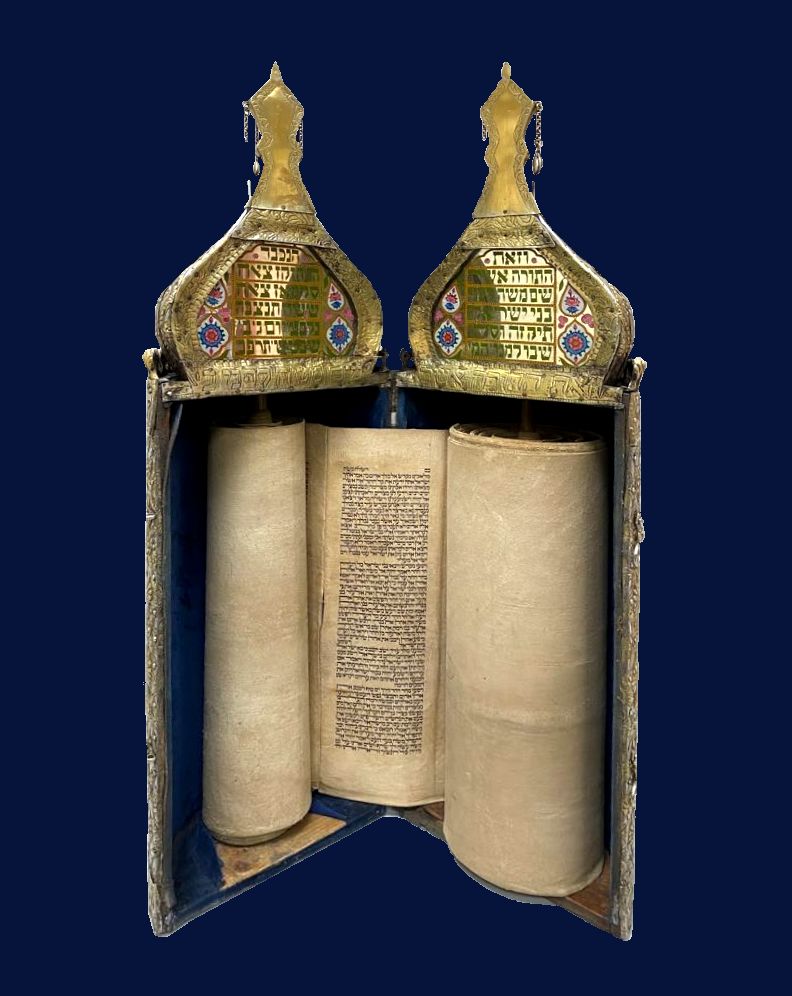From Baghdad to Israel: The Fascinating Story of a Rare Torah Scroll
The Babylonian Jewish Heritage Center often receives significant Judaica items, but the Torah scroll currently on display not only holds great historical value, it also reveals a particularly fascinating story, shared by curator Orly Becher-Levi.
 The Torah scroll (Photo: Babylonian Jewish Heritage Center) Inset: Curator Orly Becher-Levi
The Torah scroll (Photo: Babylonian Jewish Heritage Center) Inset: Curator Orly Becher-LeviA unique Torah scroll is currently on display at the 'Babylonian Jewish Heritage Center'. It is placed in a showcase at the entrance to the center, attracting much attention. In a discussion with curator Orly Becher-Levi, she notes that it is a Torah scroll with immense historical value, along with a fascinating story unveiled only because of its arrival at the museum..
Discovery in the Torah Scroll
"The Torah scroll arrived a few months ago, from the 'Aram Naharayim' synagogue in Tel Aviv, in poor condition regarding cleanliness and maintenance," she recounts. "The casing of the Torah scroll is silver-plated but was completely black. Only after cleaning it did we discover its beauty and uniqueness. The intriguing part is that, unlike other Torah scrolls from Iraq of that period, which were mainly silver-plated with minimal gold embellishments, this casing had substantial gilding. After completing the cleaning process, we deciphered the names inscribed on it, understanding who donated the scroll and the story behind it."
And what did you discover?
"We deciphered the name 'Salah Salman Sassoon' on the scroll. Since we have a large archive of documents from Babylonian immigrants, we cross-referenced the information and realized it was the renowned benefactor Salah Salman Sassoon. His sons decided to dedicate a Torah scroll in his memory back in 1922. They commissioned in Baghdad a Torah scroll written in the Baghdadi style on deerskin parchment and an ornate scroll casing decorated using a remarkable gilding technique where the metal was plated with very thin layers of gold. This technique was common among craftsmen making Torah scroll cases in Iraq, but the choice to use a significant amount of gilding gave an especially ornate appearance to this piece."
 (Photo: Babylonian Jewish Heritage Center)
(Photo: Babylonian Jewish Heritage Center)And how was the Torah scroll brought to Israel?
"We researched this too, and it turns out that the one who brought the scroll to Israel was Shaul, the son of Salman Salah Sassoon, when he immigrated to Israel in 1951. Bringing Torah scrolls to Israel was very challenging back then because every immigrant was allowed to bring only a suitcase weighing 30 kilograms, which was a difficult limitation considering they tried to bring as much of their possessions as possible. Shaul succeeded, but as we learned, upon landing, customs officials took the scroll from him, placing it in the Jewish Agency's warehouse at Jaffa Port, alongside hundreds of other Torah scrolls from Iraq.
"To retrieve the Torah scroll, Shaul Sassoon was asked to provide an official confirmation from the Babylonian Immigrants Association in Tel Aviv or Jerusalem that he was indeed the owner. Eventually, a draft of this confirmation was found in the Babylonian Immigrants archive in Tel Aviv, which later became the 'Organization of Iraqis in Israel'. Reviewing it, we learned that Shaul Sassoon intended to dedicate the Torah scroll to the 'Naharayim' synagogue in Tel Aviv."
The Fate of the Books
Here, as recounted by Becher-Levi, comes the sad part of the story of the Torah scrolls brought to Israel from Iraq. Though extracted in byways or through bribery, they were brought to the Jewish Agency warehouses and not released without documentation proving direct ownership of these Torah scrolls.
"Meanwhile," she recounts, "in 1952, a fire broke out in the Torah scroll warehouse, and many of the hundreds of Torah scrolls stored there were burned. Afterwards, the Agency decided to cease centralized storage of Torah scrolls, and those scrolls that survived the fire, whose owners couldn't prove ownership, were distributed to newly established prayer houses in transit camps and immigrant neighborhoods."
And what happened to the Sassoon family's Torah scroll?
"According to our records, Shaul Sassoon managed to prove that he dedicated the Torah scroll to the 'Aram Naharayim' synagogue in Tel Aviv, where it was placed in a Holy Ark that was essentially a wardrobe. This synagogue, located at 47 Nachalat Binyamin Street, was the first Babylonian synagogue established in the city in 1933. Since the 1950s, the synagogue became a hub for Babylonian immigrants and many store owners of Iraqi descent who lived and operated in the area."
Becher-Levi emphasizes that the uniqueness of the Torah scroll lies in its grandeur and the fact that it was brought to Israel and survived the great fire at the Agency warehouses. "This is why we chose to dedicate a special display for it, revealing its special story," she concludes.

